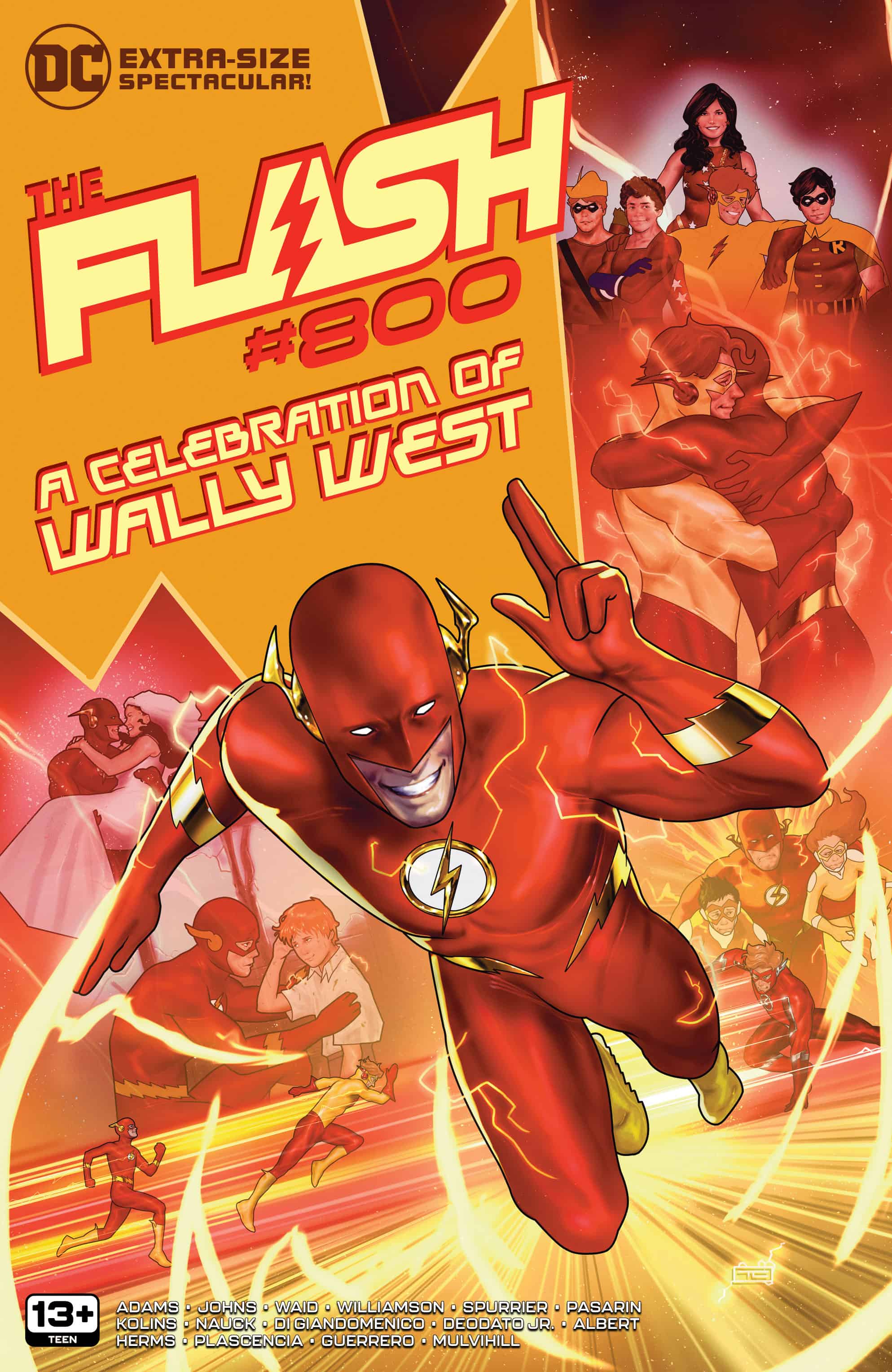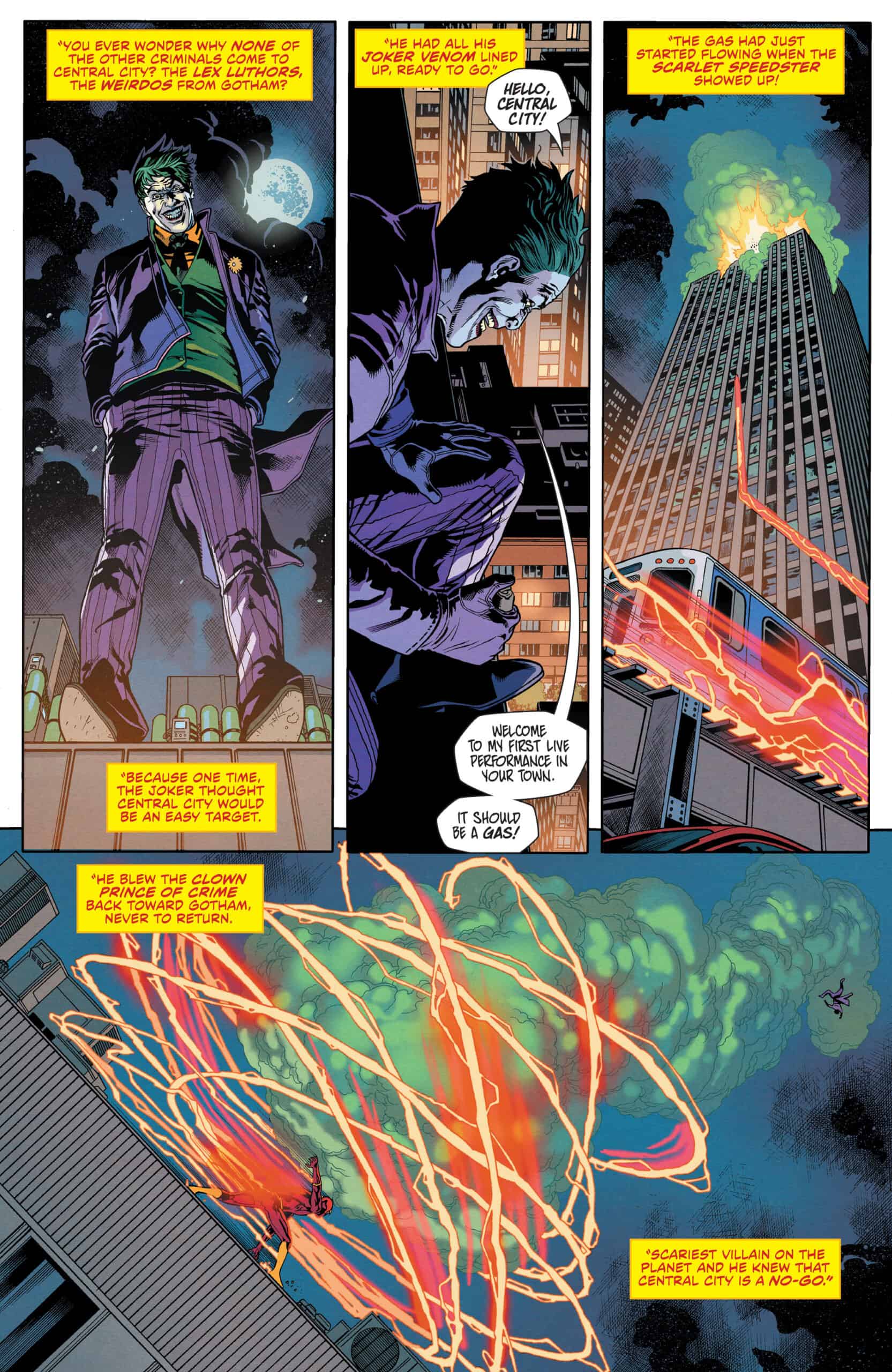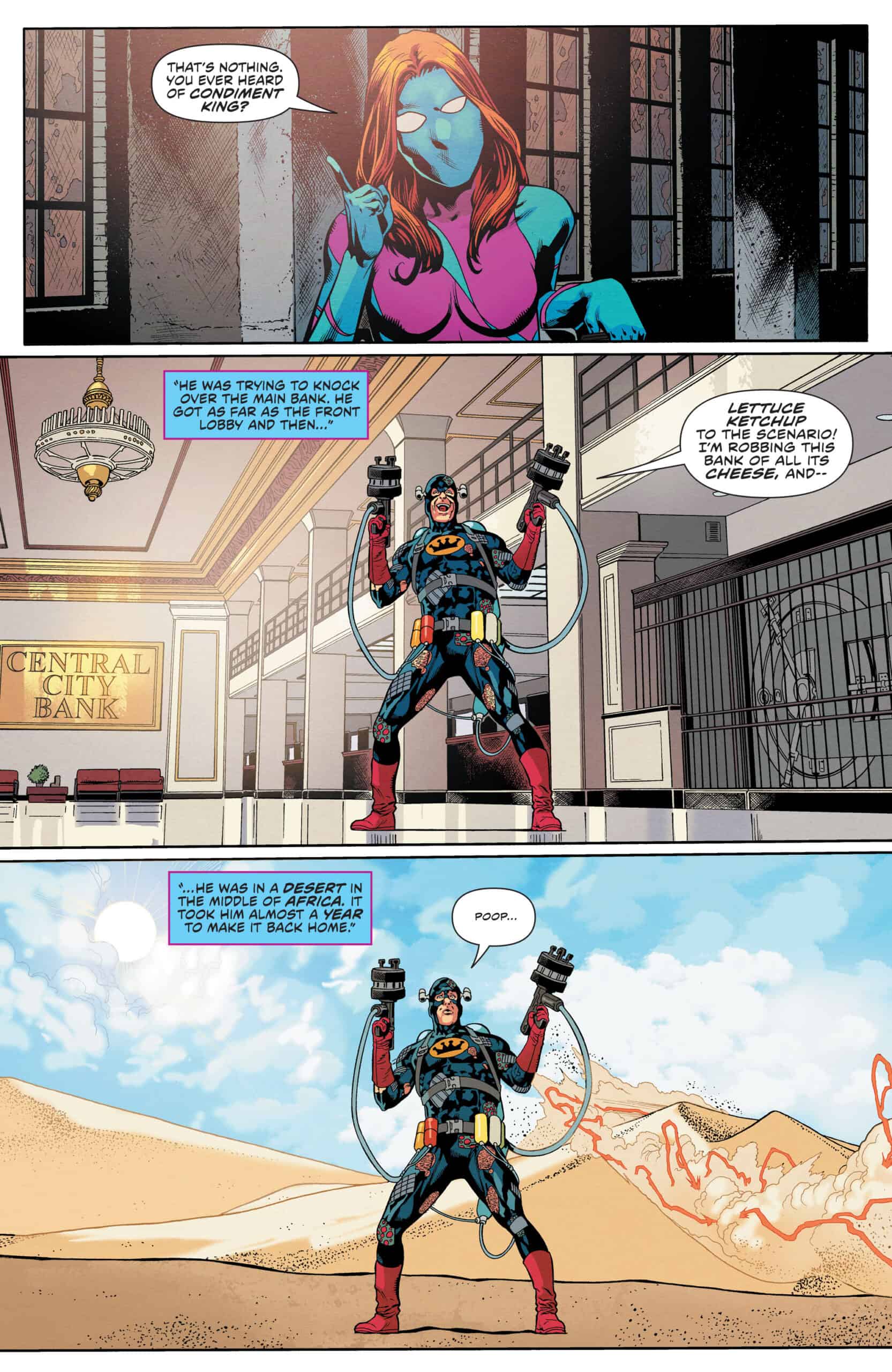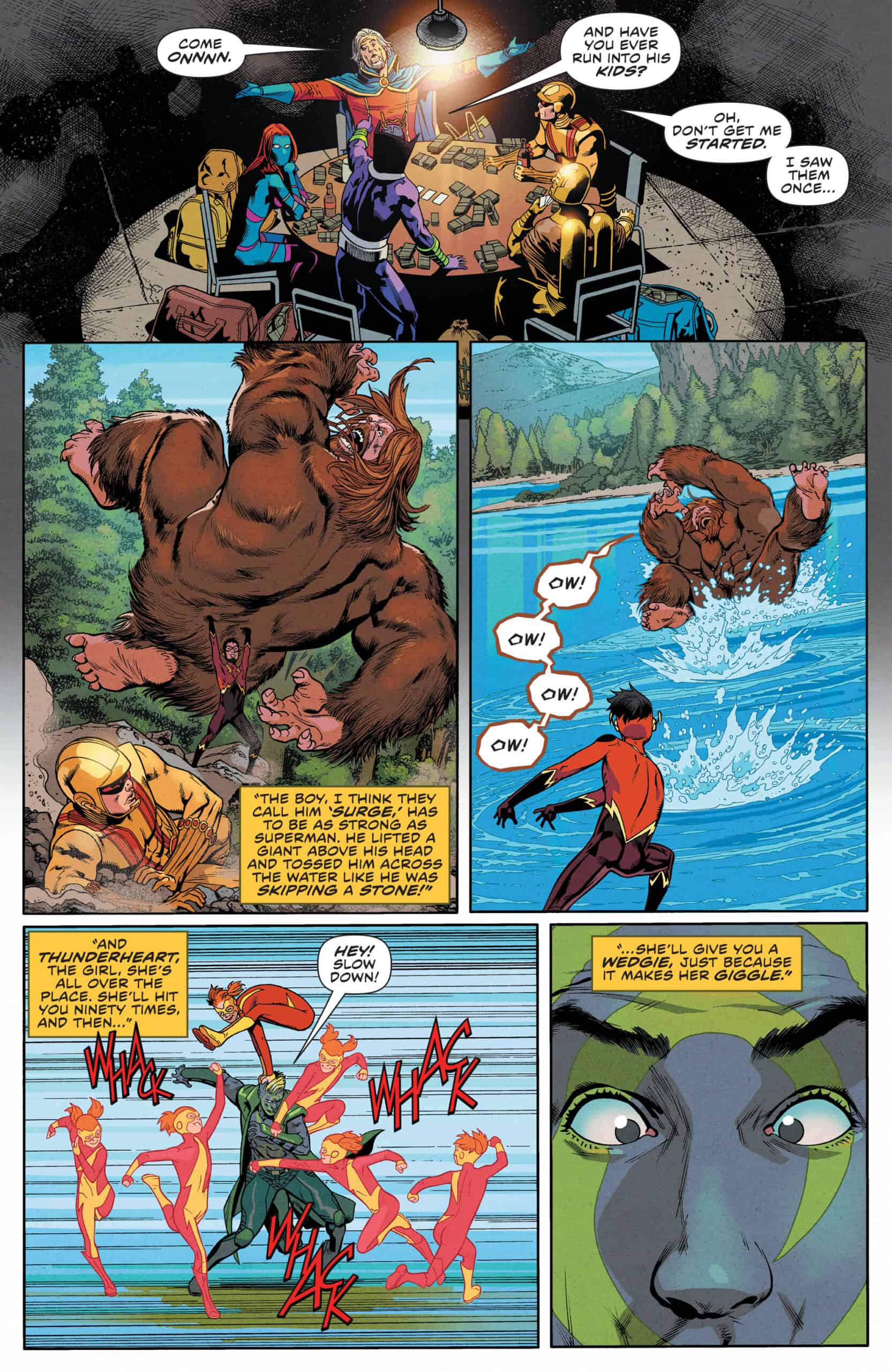The Flash #800

Recap
An oversize anniversary issue concludes writer Jeremy Adams’s acclaimed tenure, with special guests Mark Waid, Joshua Williamson, and Geoff Johns joining the celebration! As the Adams run races to the finish line, get a prelude to the new Dawn of DC chapter of the Fastest Man Alive’s adventures from the dream team of Simon Spurrier (Coda, Detective Comics) and Mike Deodato Jr. (Avengers)!
Review
This extra-sized issue starts with a short story from the creative team on the ongoing title, serving as a conclusion to their run. Plot-wise, this story follows a handful of villains discussing which city is the easiest to operate in. The debate goes from places like Gotham, Metropolis, and even Coast City (a nod to writer Jeremy Adam’s new ongoing Green Lantern title). Once Central City gets brought up, all villains start proclaiming that it is the worst. The story then pivots to short tales about how The Flash keeps the city clean, doing a better job than Batman and Superman.

This segment was a lot of fun, mainly due to the bittersweet writing of Adams. Adams mentions characters like The Flash’s kids, who have had strong appearances throughout his run preceding this. This story feels more like a thematic conclusion than anything else, with Adams pouring his love for Wally into every page. He presents Wally as a hero who takes the same level of care with a little girl who just lost her lolly pop as he does the Joker. This affirms Wally’s heroic capacity and nature and shows how drastically different he is from the rest of DC’s pantheon of heroes.

Fernando Pasarin, Oclair Albert, and Matt Herms take up art duties here, beautifully displaying this world. There should be something said about Pasarin’s depiction of The Flash, with his minimalistic take on a costume that has seen tons of iterations. Albert’s inks highlight and shade this, adding texture to the plain red attire. Herms then give this all a 3-D effect, making it look incredible on every page. This art team has done a great job on this run, and it will be a shame to see them gone.
The second story comes from long-time Wally West scribe Mark Waid, with art from Todd Nauck. Waid revisits a time in The Flash’s past to tell a short story about Bart Allen, Wally’s then-sidekick, Impulse. The focus on Bart breaks up these mostly Wally-centric tales entertainingly, making this issue come to life. Waid’s mark on The Flash is immense, and this story feels like a fun return to form, albeit in a bite-sized sense.ly, ing.
Nauck’s art highlights Bart, as his cheerful tone captures the character’s youth and inexperience. This also helps thematically as the character of Bart has always looked and acted younger than his intelligence is. It’s been a long time since Waid’s run, so fans may not remember that Impulse replaced Wally as the sidekick after Wally took over as The Flash. Nauck’s art brings this all back full circle, encapsulating the turbulent relationship between the duo.
The third story comes from Joshua Williamson and Carmine Di Giandomencio, with Ivan Plascencia taking over colors. This story revolves around a secret date that Barry takes Iris on once a year, with the voiceover coming from Wally, who highlights his appreciation for the two and their impact on his life. Williamson’s run on The Flash preceded Adams’, helping create some of the most memorable Flash stories ever. This story serves not only as a celebration of the legacy of Barry and Iris but also as a remembrance of the legacy between Barry and Wally.
This Giandomencio and Plascencia’s art works well in the shifting character panels, highlighting the different things that make Barry and Iris’s relationship work so well. The Flash, in extension, most superhero comics, is most well known for the high-flying super heroics but has become a very character-centric story over the last several years. This art helps highlight that wonderfully, making each panel hold a critical weight.
The fourth story comes from Geoff Johns, Scott Kolins, and Luis Guerrero. The report focuses on Wally’s greatest nemesis, Zoom/Hunter Zolomon, who escapes the speed force to return to his goal of making Wally a better hero. This story was the weakest of the bunch, serving only as a prelude to a level we don’t yet know. It doesn’t appear connected to the new Dawn of DC run, but it sets up a new status quo. More or less, the confusion here comes from why Johns chose this story in the first place. Is he writing a Flash story down the line? Is he working with Si Spurrier and the company?
Kolins and Guerrero’s art here works well to highlight the insanity behind Zoom, with panels crackling to show the parts of his past that helped turn him into this insane villain. Zoom has never come off crazier, and Kolins wastes no time highlighting that. Guerrero’s simple color tones help keep the focus on all the craziness, reminding readers that Zoom is formidable.
Rob Leigh does the letters for? Of these stories and his range is on full display. Each writer and artist get their definitive tone on display, and Leigh’s pivots from account to story feel natural. This is a testament to the value of a great letterer and how vital their jobs can be when bringing these words to life.

The final story here is a sneak peek into the new Dawn of DC Flash ongoing from Si Spurrier, Mike Deodato Jr, Trish Mulvihill, and Hassan Otsmane-Elhaou. This story reintroduces to the world of Wally West by breaking down the milliseconds of his life, as he has a date with his wife Linda while simultaneously stopping crime and helping people. Spurrier seemed like an odd choice for this character, but seriously… this was the most engaging story in this entire issue. Spurrier writes Wally as if he’s been working on this character for years. The way he breaks down Wally’s power in scientific terms while also personifying Wally’s heroism is unparalleled. With Spurrier as a writer, this Flash series will be unlike anything that’s come before.
Deodato has always been known for his more realistic art style, making him just as much of a puzzling choice as Spurrier regarding the creative team for this series. Thankfully, he blows this short story out of the water, using his grittier approach to highlight the uniqueness of Flash’s powers while keeping the calmer moments thematically consistent. The oddest choice here is the layout of the panels; however, they make this story flow boldly. The panel layout is usually only noted when it hinders the story, but here it keeps the flow consistent and highlights the speed at which Wally moves. The panels are not often the same size, with some starting and stopping off the page. This keeps each page exciting and mirrors speed-based powers’ chaotic nature. Mulvihill’s colors accentuate Deodato’s style, keeping everything in a darker shade that emboldens the night and lightning running through the pages.
Lastly, Ostomane-Elhaou’s letters also come through excitingly. While The Flash loses all sense of reality within the Mirror dimension, Ostomane-Elhaou messes with the lettering to highlight the fact shifting. This brings the story onto another level and creates one unique, cohesive story.
Final Thoughts
The Flash #800 excels in being a love letter to Wally West while also setting up context for a run that is likely to blow everyone’s socks off. Every story here is told well with the art team’s uniquely putting their spins on The Flash family.
The Flash #800: Passing of the Torch
- Writing - 9/109/10
- Storyline - 9/109/10
- Art - 10/1010/10
- Color - 10/1010/10
- Cover Art - 8.5/108.5/10





